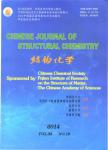Two Praseodymium Coordination Complexes with 1,3-Phenylenediacetate:Structural Diversity Tuned by Auxiliary Ligands
Two Praseodymium Coordination Complexes with 1,3-Phenylenediacetate:Structural Diversity Tuned by Auxiliary Ligands作者机构:Department of Chemistry and Chemical Engineering Yan'an University
出 版 物:《Chinese Journal of Structural Chemistry》 (结构化学(英文))
年 卷 期:2014年第33卷第11期
页 面:1623-1628页
核心收录:
学科分类:07[理学] 070304[理学-物理化学(含∶化学物理)] 0703[理学-化学]
基 金:supported by the National Natural Science Foundation of China(21373178) the Provincial College Students’Innovation and Entrepreneurship Training Program(1238) the Natural Science Foundation of Yan’an University(YDZ2013-09)
主 题:praseodymium(Ⅲ) complexes,crystal structures,fluorescence properties
摘 要:Two new coordination complexes, [Pr(1,3-pda)0.5(nbca)2(H2O)2](1) and [Pr2(1,3-pda)3(2,2ˊ-bpy)2(H2O)2](2)(H2pda = 1,3-phenylenediacetic acid, Hnbca = 5-nitro [1,1ˊ-biphenyl]-3-carboxylic acid, 2,2ˊ-bpy = 2,2ˊ-bipyridine), have been synthesized under hydrothermal conditions and characterized by elemental analysis, IR spectra, and single-crystal X-ray diffraction. In 1, the nbca ligands bridge the Pr3+ ions to form a 1D chain. Moreover, these 1D chains are united together through the 1,3-pda ligands to afford a 2D layer. In contrast, due to a different auxiliary ligand, complex 2 is a 2D layer linked through only bridging deprotonated 1,3-pda. Thermal stabilities and solid fluorescence properties of 1 and 2 were also studied.



